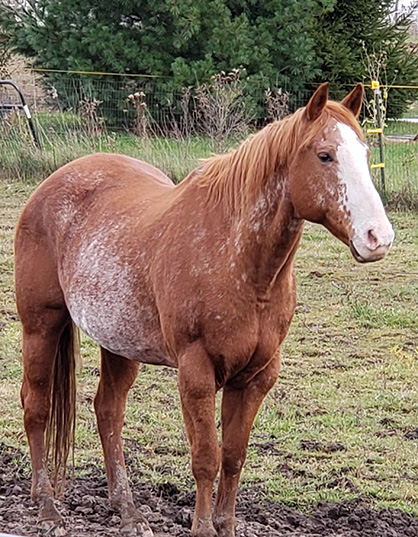A Paint Horse’s Struggle With Equine Cushing’s Disease

Valley Vet
Dodger’s Story With Equine Cushing’s Disease
Pituitary pars intermedia dysfunction (PPID), also referred to as Equine Cushing’s disease, is one of the most common endocrine disorders in horses.
After 17 years of marriage, she heard her husband say he was ready for a horse of his own. Casey Olson, an equestrian since age 5 who has ridden in everything from dressage to barrel racing, was thrilled. Trying her best to contain her excitement, she asked Chris what his dream horse would be. Finding a “tall, broad, safe horse with ‘cool coloring like a Paint,’” would be a tall order to fill. But within just two weeks, Casey found a horse that more than checked all the boxes – an 18-year-old Paint horse named Dodger. “He instantly fell in love with him. He’s a perfect fit,” Casey said.
“When he came to us, he was extremely overweight with a crested neck. His mane moved like a separate entity. It was like he was bubble-wrapped,” Casey said. ”We put him on a slow weight-loss diet, but during the winter, we noticed he wasn’t holding his weight well. His coat has gotten long and curly, his mane was wavy and he was losing all of his top line. When spring came, the other horses were shedding, but Dodger didn’t shed at all.”
Perplexed, Casey put in a call to her veterinarian, who also cared for Dodger when he was with his previous owner. During his examination, she knew right away there was something different about him. His coat condition and weight had never been an issue before, and he was receiving excellent care. The likelihood he had developed Cushing’s Disease was high, but thankfully they had caught it early.
“We finally had our answer,” Casey’s husband, Chris, said. “It was not great news, but we knew what we needed to do now.”
Cushing’s disease in horses
Cushing’s disease, also more correctly referred to as Pituitary Pars Intermedia Dysfunction (PPID), is a common hormonal disorder affecting horses and ponies. PPID has reportedly been identified in 21% of horses over the age of 15; however, horses as young as 5 have been diagnosed with the disease, studies report. The disease causes the horse’s pituitary gland at the base of the brain, which controls body functions through hormone levels, to work double-time, which results in a variety of lifelong problems for affected horses. Often, signs go unnoticed.
Symptoms
- Decreased athletic performance
- Loss of muscle mass
- Change in attitude or energy
- Delayed shedding or no shedding at all
- Excess fat on tail head or neck
- Infertility
- Abnormal sweating
- Laminitis
- Blindness
Experts recommend that horse owners perform frequent health checks to identify early signs. An early diagnosis can have a profound impact on how the horse responds to treatment before other signs appear.
Treatment
Prascend is FDA-approved to manage Cushing’s in horses, improving an affected horse’s well-being and overall quality of life, reducing common signs and risks for other illnesses associated with the disease. “Right now, Dodger is on one pill of Prascend a day,” said Casey, who ordered the prescription medication from Valley Vet Supply. “My vet said, ‘Valley Vet is great; if you put the order in, they’ll send me the prescription request.’ It was easy.”
Dodger is no longer suffering from abnormal sweating, weight loss and a poor coat. With the treatment he has received, he now sports a healthy weight and shiny coat. His regular energy has returned, so Chris can enjoy trail rides with him again.
In conjunction with treatment, implement best management practices to help keep a PPID horse healthy and comfortable.
- Provide a balanced diet. Casey, who developed an impressive chart comparing feeds to ensure the best diet for their horse Dodger, advises others managing the condition to “Watch the starch and sugar contents of everything that goes in your horse’s mouth.” Low-sugar, low-starch diets are often the best approach for horses with PPID.
- Deworm as needed. Horses with PPID have shown to have higher fecal egg counts, suggesting greater risk for a higher parasite burden.
- Vaccinate against disease threats. Ensure horses are vaccinated against core equine diseases and any risk-based diseases that could threaten his well-being. Horses with advanced PPID may need to be vaccinated twice yearly against West Nile virus to help ensure a sufficient immune response.
- Clip coats and blanket when necessary. Horses with PPID often have varying consistency of coat shedding, some shedding too frequently while others barely shed at all. Keep them comfortable by clipping their coat in the summertime and blanketing them in the wintertime.
- Maintain a regular dental and hoof care schedule. Implement a yearly or as-needed dental care schedule, and ensure hooves are trimmed on average every six to eight weeks.
Casey shared how difficult it was for her to see her husband Chris going through all of this with his first horse. “It was a crash-and-burn lesson into horses. We want to do what’s best for Dodger, and we will.”
“I would do it all again,” said Chris. “Dodger has such a personality, and he is a great trail horse that I can trust.”
Visit ValleyVet.com for horse health needs, and to learn more.
About Valley Vet Supply
Valley Vet Supply was founded in 1985 by veterinarians to provide customers with the very best animal health solutions. Building on over half a century of experience in veterinary medicine, Valley Vet Supply serves equine, pet and livestock owners with thousands of products and medications hand-selected by Valley Vet Supply founding veterinarians and their professional staff. With an in-house pharmacy that is licensed in all 50 states, and verified through the National Association of Boards of Pharmacy (NABP), Valley Vet Supply is the dedicated source for all things horse, livestock and pet. For more information, please visit ValleyVet.com.










